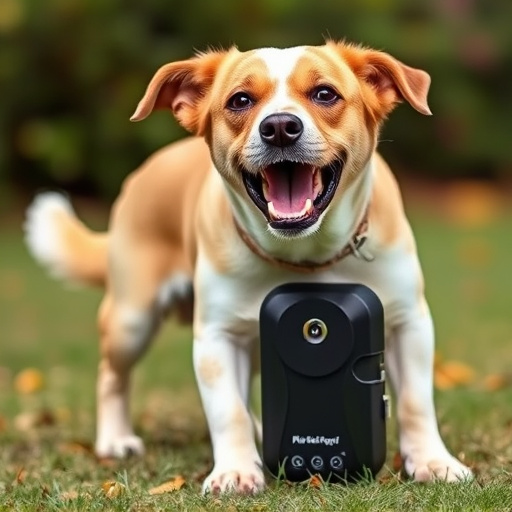Understanding canine communication is key for effective training. Ultrasonic devices emit inaudible high-frequency sound waves (above 25 kHz) at safe power levels to deter unwanted behaviors like barking or jumping, conditioning dogs without harm. These tools appeal to dogs' natural sensitivity to sound, promoting positive reinforcement while strengthening the bond between pets and owners. To use effectively, start with low settings, increase gradually as needed, maintain consistency during training sessions, and pair activations with commands to avoid fear or distress in dogs.
“Unleash the power of sound to transform your dog’s behavior with ultrasonic frequency devices. This innovative tool offers a humane and effective approach to addressing common canine issues. By understanding your dog’s reaction to specific frequencies, you can adjust the device’s safe power levels for optimal results. Explore the science behind these tools, their numerous benefits, and essential training tips for responsible use. Discover how to modify your dog’s behavior gently yet firmly.”
- Understanding Dog Behavior and Ultrasonic Devices
- How Safe Power Levels Ensure Non-Harmful Deterrents
- The Science Behind Ultrasonic Frequency Dog Tools
- Benefits of Using a Dog Deterrent at Optimal Power Levels
- Training Tips for Effective Implementation
Understanding Dog Behavior and Ultrasonic Devices
Understanding dog behavior is key to effective training and modification. Dogs communicate through a variety of signals, from body language to vocalizations, all designed to convey their intent and emotions. Ultrasonic devices, specifically those emitting sounds beyond human hearing range, have emerged as innovative tools in canine behavior modification. These tools operate at safe power levels, ensuring they are non-harmful to dogs while effectively serving as deterrents. By targeting specific behaviors, like barking or jumping, ultrasonic frequencies can condition dogs to associate certain actions with unpleasant yet harmless sensations. This approach leverages a dog’s natural sensitivity to sound, promoting positive changes in their behavior without resorting to harmful training methods.
How Safe Power Levels Ensure Non-Harmful Deterrents
Ultrasonic frequency dog behavior modification tools operate on the principle of emitting high-frequency sound waves that are inaudible to humans but irritating to dogs. The effectiveness of these devices lies in their ability to deliver safe power levels, ensuring they act as non-harmful deterrents. This is crucial, as it prevents any physical discomfort or harm to the animals while still encouraging desirable behavior changes.
By using precise and controlled safe power levels, these tools can effectively communicate with dogs without causing them pain. This approach respects the animal’s well-being while allowing owners to train their pets through positive reinforcement and deterring unwanted behaviors like barking, jumping, or chewing.
The Science Behind Ultrasonic Frequency Dog Tools
The science behind ultrasonic frequency dog behavior modification tools revolves around a principle that leverages sound waves to communicate with canines. These devices emit high-frequency sounds, typically above 25 kHz, which are inaudible to humans but can be heard by dogs. The specific frequencies target different behaviors; for instance, higher pitches often deter barking while lower ones can encourage calmness. This technology ensures safe power levels, making it a dog-friendly deterrent without causing harm or discomfort.
Ultrasonic tools operate on the principle that dogs have a more sensitive hearing range compared to humans. By emitting sounds beyond our perception, these devices can be used to train and modify behaviors like excessive barking, jumping, or aggression. The safe power levels are designed to be non-intrusive, allowing for effective behavior modification while maintaining the dog’s well-being and emotional integrity.
Benefits of Using a Dog Deterrent at Optimal Power Levels
Using a dog deterrent at safe power levels offers several benefits for both pet owners and their canine companions. Unlike traditional punishment methods, which can lead to fear or aggression, ultrasonic frequency devices operate at optimal power levels to gently guide dogs away from unwanted behaviors. These tools emit high-frequency sound waves that are inaudible to humans but disruptive to dogs, effectively redirecting their attention without causing harm.
This approach is particularly effective for modifying behaviors like excessive barking, jumping on guests, or chewing on furniture. By targeting specific behaviors and using safe power levels, owners can teach their dogs alternative actions while fostering positive reinforcement. As a result, the relationship between pets and their owners strengthens, leading to happier and better-behaved dogs.
Training Tips for Effective Implementation
When using an ultrasonic frequency dog behavior modification tool, it’s crucial to implement safe power levels for effective training. Start with the lowest setting and gradually increase as needed, observing your dog’s reaction closely. This approach ensures that any discomfort is minimal while still encouraging desired behaviors. Consistency is key; use the device at regular intervals during training sessions to reinforce positive behavior.
Incorporate these tips for best results: avoid using it for extended periods without breaks, and pair its activation with specific commands or actions to help your dog associate the ultrasonic frequency with their desired behavior. Remember, a safe power level dog deterrent should enhance learning, not cause fear or distress.
Ultrasonic frequency dog behavior modification tools, when used with safe power levels, offer a non-harmful yet effective deterrent for canine behavior issues. Backed by scientific principles and proven benefits, these tools can be integrated into training routines to correct unwanted behaviors. By adhering to optimal power levels, pet owners can foster positive changes in their dogs’ behavior while ensuring their safety and well-being. Remember, consistent training methods and a deep understanding of dog behavior are key to successful implementation.
